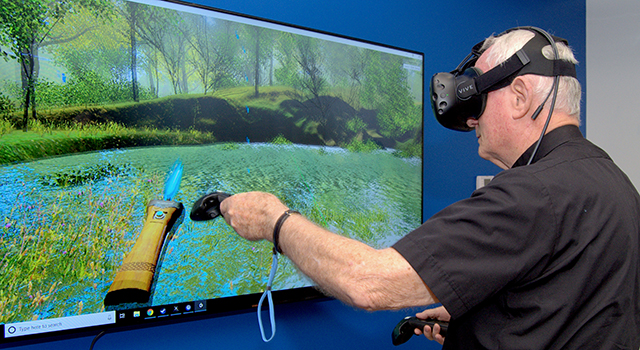By Jim Davis - Florida Catholic
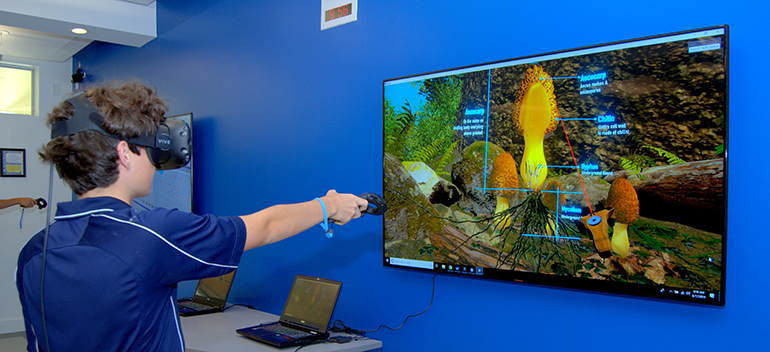
Photographer: JIM DAVIS | FC
Matt Jahnes opens a 3D image of a mushroom on a virtual reality system at St. Thomas Aquinas High School.
FORT LAUDERDALE | Ally Columbus pulled a heart and ribs out of a pig carcass, without donning latex gloves or smelling formaldehyde.
Matt Jahnes, a fellow student at St. Thomas Aquinas High School, shrank so small that he could stand on a mushroom cap.
And Catherine Brinis and Leo Bonifanti peeled away a man’s skin, muscles and nervous system to reveal his skeleton.
That and more is made possible by strides in digital imagery, technology that is now reaching high schools like Aquinas. Teachers, students and administrators alike say it boosts learning and encourages exploration in STEM (science, technology, engineering and mathematics).
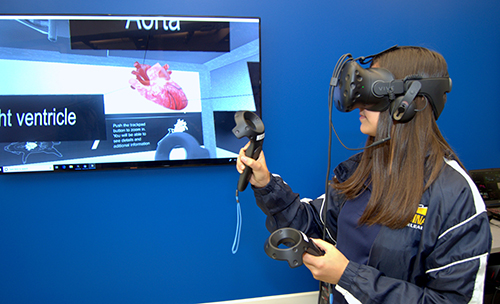
Photographer: JIM DAVIS | FC
Ally Columbus removes an image of a heart from a pig via a new virtual reality system at St. Thomas Aquinas High School.
“More real, more easy to learn,” was the quick summation of science teacher Beth McTighe. She said the technology complements the usual books and lectures in several fields — anatomy, biology, physics, even math.
For Erin Williams, STEM coordinator at the school, the technology reinforces the textbook materials.
“We’re trying to give the student many opportunities to refine their knowledge in science,” she said. “We can impress the facts on them a different way.”
New this year at Aquinas are two virtual reality (VR) systems that immerse students in a three-dimensional world. When they slide a visor over their eyes, they see a vivid computer-generated world all around them. Using hand-held controllers, they can move around in it, hold objects, even change their own relative size.
During a recent introduction of the devices, Jahnes appeared to shrink small enough to wander in a forest of towering mushrooms. He gestured with a controller, and a mushroom opened, with pop-up labels naming each part. A 75-inch monitor on a wall showed other students what he was seeing.
On the other VR system, a technician loaded a pig dissection lesson for senior Ally Columbus. Using the controllers, she made an incision and pried it open. Then she reached inside and extracted the heart and several ribs.
FOR VISUAL LEARNERS
“Ewww,” she said with a smile. But afterward, she gave the experience a thumbs-up. “I don’t like dissection, but this is way better than doing it in person,” Columbus said. “I think every student ought to experience this.”
Nick Boulanger, one of about 30 students watching the demo, said the system helps to level the field for different learning styles.
“It’s good for visual learners, who need to see something to learn,” said Boulanger, a senior who said he’s interested in pre-medical studies. “Everyone can learn their own way.”
The mushroom and dissection routines are two of 10 “experiences” on the VR system. You can also measure the doppler effect of a train as it rushes through a station. You can see how a flying bat navigates a cave with echolocation. You can learn how lenses and mirrors affect light. You can assemble electronic parts on a circuit board. You can even step inside a beating human heart and examine the chambers.
The VR system also allows a student to mix volatile chemicals without the risk of getting singed eyebrows. “That’s why kids want to take chemistry — everyone says, ‘I want to blow something up,’” STEM coordinator Williams said with a smile.
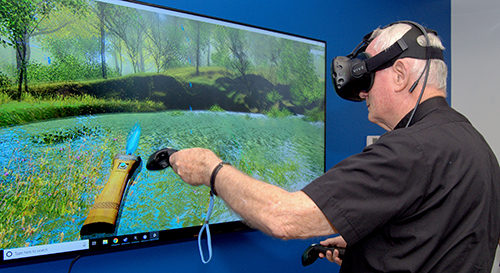
Photographer: JIM DAVIS | FC
Msgr. Vincent Kelly, former supervising principal at St. Thomas Aquinas High School, tries out the new virtual reality system during a student assembly.
Amazingly, the two systems use no exotic hardware — they’re on ordinary gaming computers, which usually handle the likes of World of Warcraft and Call of Duty: Black Ops. The difference is the software developed by Xennial Digital, the Miami-based firm that donated the system.
Xennial usually makes digital presentations for companies and cruise lines. The VR learning system represents an effort to broaden into education.
“We wanted to connect with a progressive school,” said CEO Douglas Fajardo, whose son, Jorge, is a senior at Aquinas. “And we want to showcase this technology to other schools, to show the impact it has on students.”
DESIGN, SHAPES, TEXTURES
Another advantage: The programming is all on the one-terabyte storage of each computer. That makes it a standalone system, free from the need for an internet connection. The goal is to make it available anywhere a school teaches STEM coursework, Xennial officials said.
Once the deal was made, Xennial teams asked what kind of content Aquinas educators needed. Then the teams built each experience layer by layer: design, shapes, textures, how objects interact, how the controllers work, what someone sees through the visor. Each project took six to eight weeks for a team of three to five.
Williams related the process to a Catholic value: “The many are one. We’re all in this together, in a partnership between the school and the company and the students.”
Even Msgr. Vincent Kelly, former supervising principal at Aquinas, tried out two “experiences” through the visors. He found it a “bit of a Pollyanna or Wizard of Oz world,” but voiced enthusiasm for the “energy and excitement” it adds to learning.
He added that VR learning may even benefit spirituality because it encourages exploration. “The heart and mind is always searching, and the search leads beyond what’s imaginable. You start to ask what’s it all about. And the ultimate exploration is to discover God.”
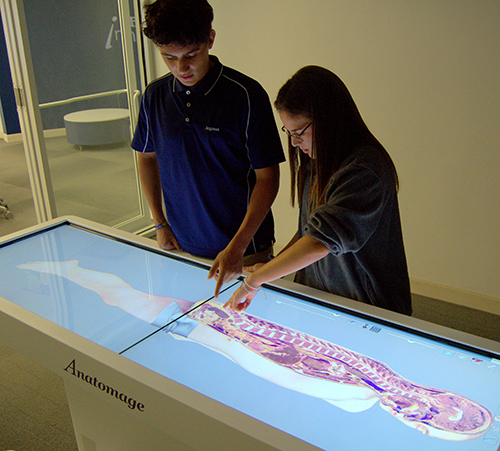
Photographer: JIM DAVIS | FC
Senior students Catherine Brinis and Leo Bonifanti work with the new virtual dissection table at St. Thomas Aquinas High School. The table is touch sensitive, allowing users to move or rotate the image with a finger.
The VR system follows installation of a virtual dissection table late last year, also by donations. Made by San Jose-based Anatomage, the table projects full-length views of a human cadaver and its various layers — muscular, skeletal, nervous, digestive and pulmonary systems — and labels the parts.
The table is touch sensitive, with sensors along the rim, so a student can rotate the body — lengthwise, crosswise, even at angles — with a finger.
Based on information from real cadavers, the table assembles 2,000 3D images to show layers and slices of the various tissues. Students can view a cross-section of a muscle, organ or other structure.
“You can even slice off a big toe,” joked Lizette Foley, Aquinas’ director of instructional technology.
HOW THEY FIT TOGETHER
Only a few students can work on the table at any time, but two 75-inch wall monitors allow other students to see what’s happening.
Packed into Anatomage’s software is a library of facts. They include images of a liver distended by cancer, an ACL knee injury, and an ectopic pregnancy. A head and chest display shows close-ups of things like a stab wound and a stent placed in an artery. And you can trace the flow of blood from the heart into the lungs.
The table can even teach veterinary science, with images of animals like a dog, a cat, a parrot, a tortoise, even a squirrel-like Australian creature called a sugar glider.
“We get a lot of tests from books, but here we see how things fit together,” said senior student Catherine Brinis, who plans to go into sports medicine. “This isn’t memorizing — it’s understanding.”
She said the table system helped her realize that “God is in control — even down to little things like a heart valve.”
Fellow senior Leo Bonifanti, who is also interested in medicine, agreed. “The way God created us, the intricacies in keeping us alive — so many millions of things can go wrong, it’s amazing that they seldom do.”
Foley, who trains teachers how to use the table, said some of them are less than comfortable with the technology — but their minds change when they see their students’ reactions.
“The teachers love it because the kids love it,” she said. “The kids are digital natives.”
Like Msgr. Kelly, science teacher Beth McTighe says the tech can further Catholic values.
“It makes students more respectful of the human body,” McTighe said. “It helps them respect life, from conception to death.”
“God made us, and the technology shows what a wonderful job he did,” she added.
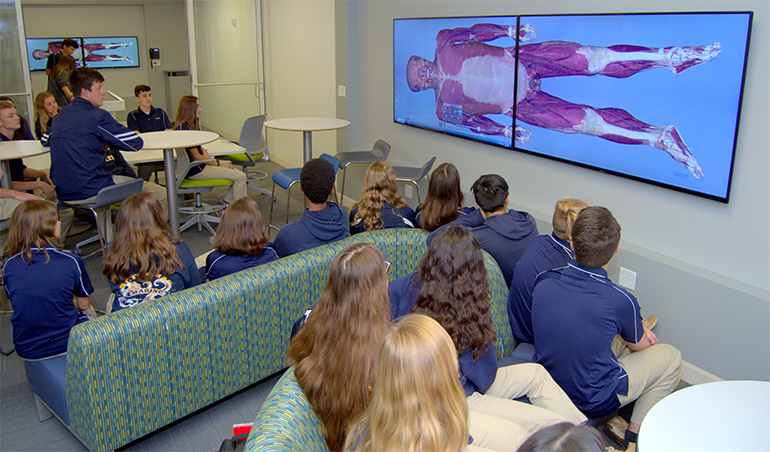
Photographer: JIM DAVIS | FC
Students in the Innovation Center at St. Thomas Aquinas High School watch a full-size monitor image of a virtual cadaver, being examined by students in left background.
This article has been corrected to reflect Msgr. Vincent Kelly's position: He is former (not current) supervising principal of St. Thomas Aquinas.
